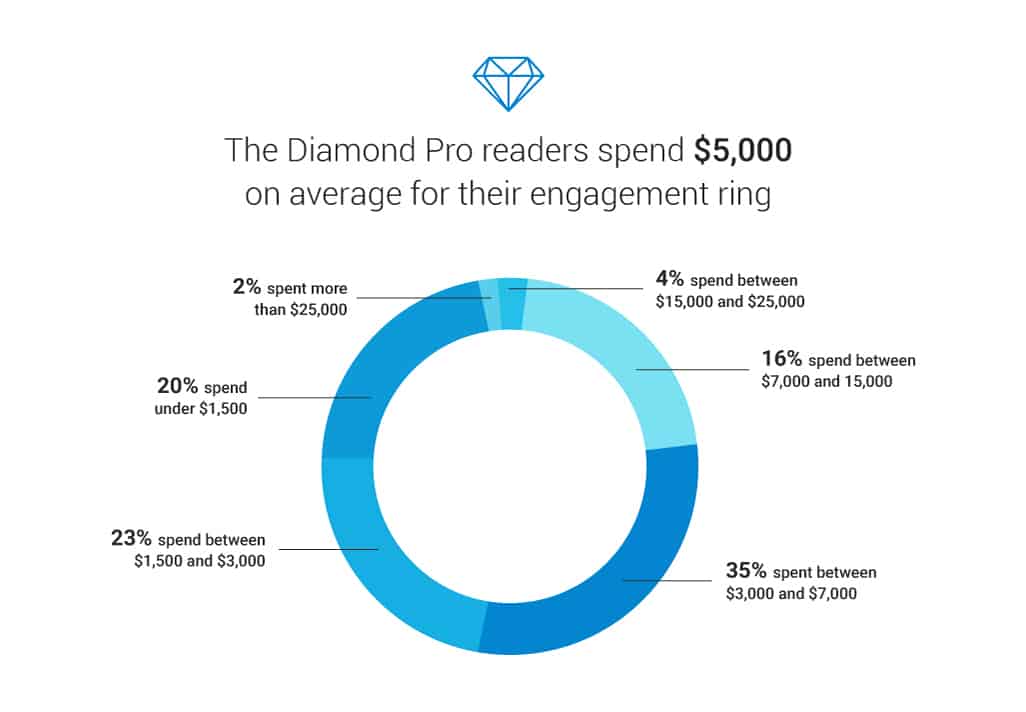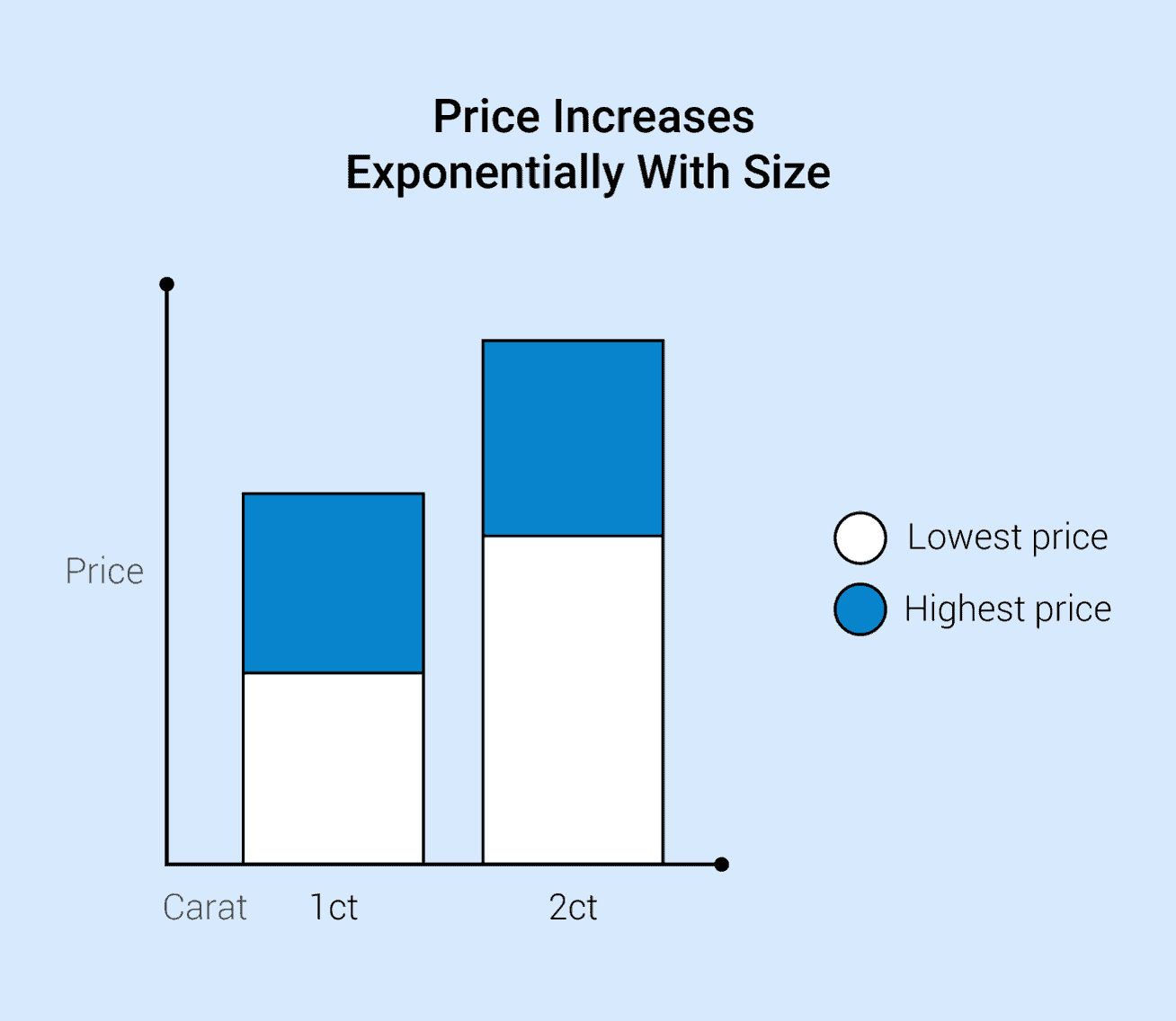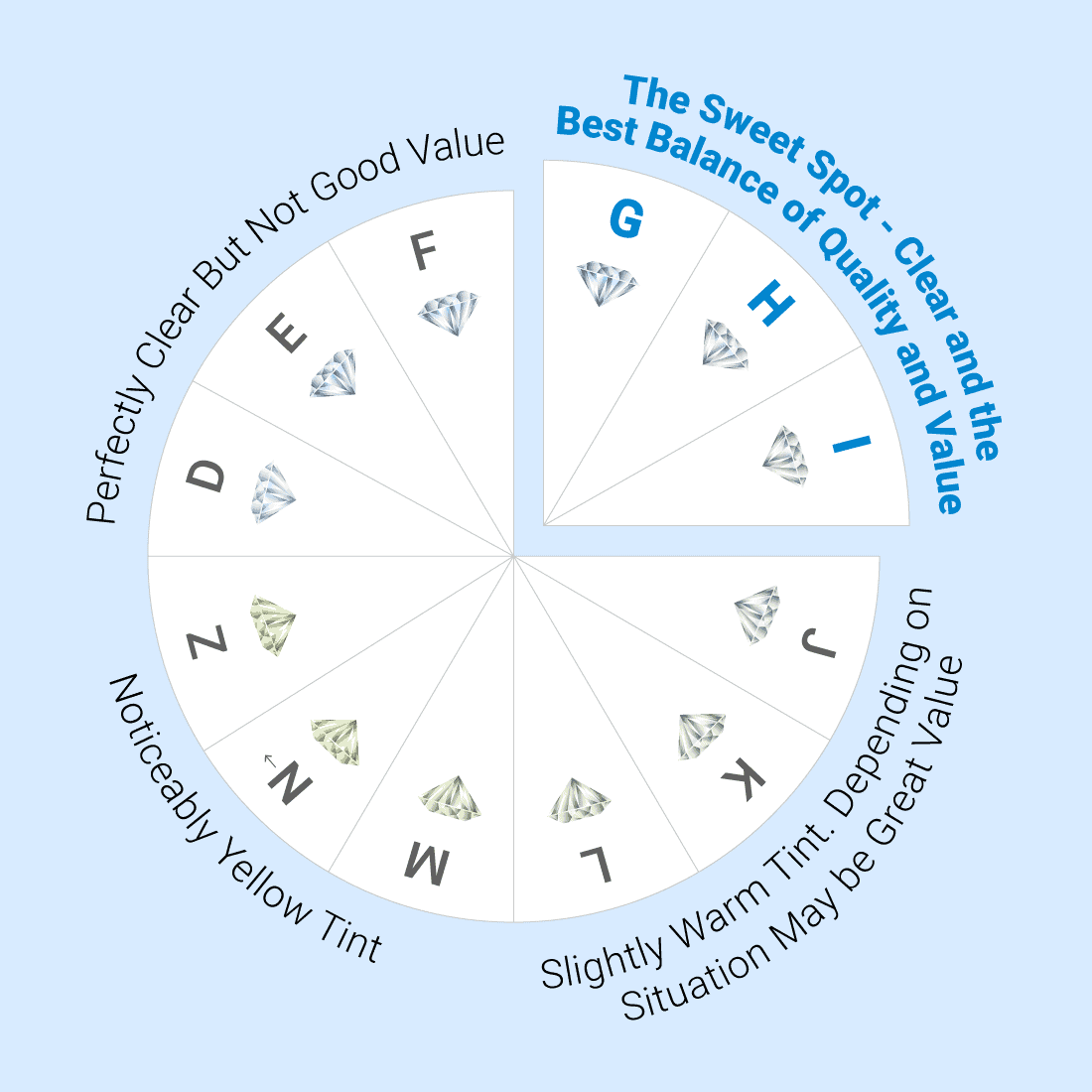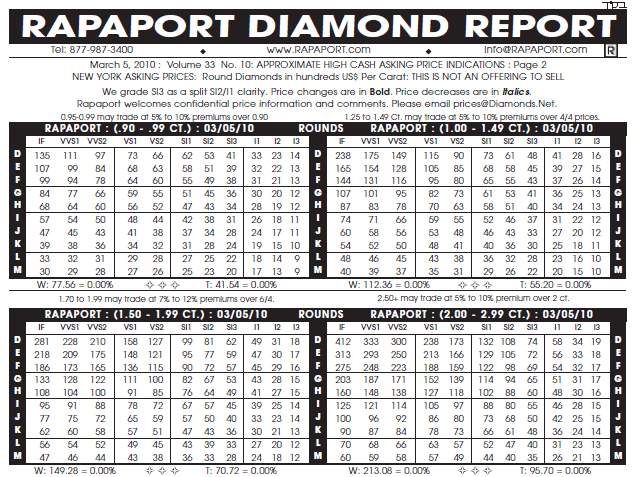Diamond Prices: A Complete Guide
How to Calculate a Diamond’s Price, Value & Worth
How to Calculate a Diamond’s Price, Value & Worth
A diamonds’ price is determined primarily by the 4 Cs of the diamond. On the wholesale level, diamond prices are first based on a diamond shape and size range (e.g. 1.00ct – 1.49ct). After that, it is broken down by color and clarity and then priced per carat. That price is then multiplied by the specific weight of the diamond. Other qualities impact the price as well such as cut, fluorescence, types of imperfections, etc.
| Diamond Carat Weight | Price (Per Carat, Round Brilliant Cut) | Total Price | Diamond Example |
|---|---|---|---|
| 0.50 carat | $990 – $5,000 | $495 – $2,500 | Click here for diamond from Blue Nile |
| 1.00 carat | $2,000 – $14,000 | $2,000 – $14,000 | Click here for diamond from James Allen |
| 1.50 carat | $3,300 – $24,000 | $4,400 – $30,000 | Click here for diamond from Blue Nile |
| 2.00 carat | $4,200 – $29,000 | $8,400 – $58,000 | Click here for diamond from James Allen |
| 3.00 carat | $7,200 – $51,000 | $21,600 – $153,000 | Click here for diamond from James Allen |
| 4.00 carat | $8,400 – $71,500 | $33,600 – $286,000 | Click here for diamond from James Allen |
| 5.00 carat | $9,600 – $67,500 | $48,000 – $337,500 | Click here for diamond from Blue Nile |
Buying a diamond is confusing. On the surface, it seems like nothing makes sense. Take a look at this 2 carat diamond from James Allen and compare it to this 2ct diamond also from James Allen. They’re both two-carat diamonds. Does it make sense that they’re the same size, yet one costs $6,100 and the other $17,740? To make it even crazier, the 17k diamond is actually the better deal!
There are a lot of details that factor into a diamond’s price. In this article, we’ll cover these from D – Z (diamond color grade pun).
Here’s what we’ll cover on this page:
What are current diamond prices?
What are the key steps to buying a diamond?
Free diamond price calculator
How are diamond prices calculated?
How can I save money when buying a diamond?
What is the Rapaport Diamond Price List?
Bottom Line Recommendations
Why you should trust us
It’s actually possible for the price range per carat to be wider than this. For example, a diamond with very low color and clarity grades (for example, M and I1) might cost slightly less per carat than the price ranges listed above.
However, is this a desirable diamond? Outside of certain circumstances, most likely not. At the other end of the scale, the highest end of the price ranges listed above is reserved for diamonds with exceptionally high color and clarity grades, which often don’t offer ideal value for money.
When talking about diamond prices, there are two priorities: The retailer that offers the best value and focusing on which specific diamond gets you the best bang for your buck. We have an article that reviews the best places to buy a diamond. Below we will be getting into the nitty gritty details that determine the price of a specific diamond.
It’s important to understand this so that you can determine what is important for you when making this purchase. Take a beautiful G VS1 1 carat diamond and compare it to an E VVS2. You can’t see any difference between the two, but you can see the 20% difference in price.
The last few years have seen a surge in interest in lab-grown diamonds. Lab-created diamonds are an option if you are willing to go on a less traditional route. As we discuss here, they are significantly cheaper and offer you more flexibility in your budget. If you do decide to go for a lab-created diamond, we recommend James Allen.
>>MORE: Find the Best Value Diamond for Your Budget
When discussing pricing and what is a fair deal, you have to know what you want and how to be sure you are getting what you are paying for. You need to make sure you are following the process to ensure you aren’t getting scammed. It’s hard figuring out how much you should spend on a diamond. It’s just as hard figuring out how to get the best bang for your buck.

1) Certification – This is the most important step. It is an absolute must if you are spending more than $1,000 on a diamond. The purpose of buying a diamond with a certificate is to have peace of mind that you are getting what they claim. The only certificate that provides that is the GIA laboratory. GIA is the gold standard for the diamond industry.
2) Quality – Now that we know which certificates to use, we need to understand all the qualities listed on the certificate and what we should do with that information. You may have heard of the 4 Cs of diamonds and we have articles on each of them: color, clarity, cut and carat.
I will use color as an example. If you decide to go with an elegant solitaire setting, you can focus on J+ to maximize value. But if you are going for a more elaborate halo setting like this one from Blue Nile, you will need to stick with H+.
I understand that this gets a bit confusing trying to balance the different diamond proportion and qualities. If you prefer more personal help guiding you through the qualities, feel free to contact us.
3) Pricing – There are two aspects to diamond pricing; the natural ebb and flow of the diamond market pricing and whether the diamond you are buying is a good deal. Diamonds, like any industry, have their ups and downs. According to Rapaport, an industry authority on wholesale diamond pricing, “the global recession in 2008/2009 reduced the size of the personal luxury goods market by 8-10%”.
The easiest way to figure out the price is the same way you do with anything else: Shop around. Blue Nile and James Allen are the industry leaders when it comes to diamonds (like Amazon is for many products). A store will always be more expensive than what you can find online, but figure out the right baseline and then you can decide if it’s worth paying premium “X” for the added value you feel you are getting from the store.
For example, we reviewed Shane Co and were offered a 1.01ct I VS2 cushion cut for $6,477. Firstly, had you gone through our education on quality, you would know that this was an undesirable diamond (cut a little too deep and better to avoid “I” color in cushion cuts). Next, we can do a quick price comparison. Here is a superior diamond from Blue Nile (better cut, higher clarity) that is a fantastic deal coming in at $3,160.
You don’t need me to tell you that the Shane Co diamond is horrifically priced.
Use this Diamond Price Calculator to calculate the expected range of prices for different diamonds.


Calculator ![]()


Diamond prices can vary hugely depending on a diamond’s shape, cut quality, clarity and color. For example, the cost of a one carat diamond can range from just $1,500 to more than $16,000 for an extremely well-cut, high-quality diamond, while a two carat diamond could cost as little as $6,000 or as much as $80,000 based on its shape, cut, clarity and color grades.
As you can see, this is a huge range, with some diamonds costing as much as 10 times higher than other diamonds of the same carat weight.
Diamond prices depend on such a wide range of factors that’s very difficult to give an accurate price estimate for “diamonds” as a whole. The biggest of these are the four Cs, which we briefly mentioned earlier — cut quality, clarity, color and carat weight.
The better a diamond’s four Cs (or, in the case of carat weight, the higher) the more expensive it will be. In short, the better a diamond’s quality, the more you’ll need to pay to purchase it.
Now, this doesn’t mean that you can’t get a good quality diamond without paying a fortune. With diamonds, the key is to maximize the amount you spend on the factors that affect the diamond’s appearance, all while minimizing the amount you spend on the factors that don’t.
We’ve covered this in more detail further down the page. For now, let’s start by looking at how a diamond’s price is calculated based on its carat weight, color, clarity and other factors.
As we mentioned above, diamonds are all priced per carat. Let’s say a 0.50 carat diamond has a price of $1400 per carat. That diamond’s price for the stone would be $1400 * 0.50, or $700. Or, let’s say that a 1 carat diamond has a price of $4,100 per carat. This one is easy to calculate — since the diamond is 1 carat, the price for the stone is exactly the same — $4,100.
Diamond prices per carat increase as you jump up to higher weight categories. In short, the higher the diamond’s carat weight, the higher the total amount you’ll need to pay per carat to purchase the diamond.
Therefore, diamond prices increase exponentially with weight, since their prices increase both due to the increased weight and due to the higher price per carat for the increased weight category.
The price of a 1 carat diamond is between $1,300 and $16,500, depending on factors such as the diamond’s cut quality, clarity, color and shape.
Below, we’ve listed the average price ranges for 1 carat diamonds in all 10 of the most common shapes. Like above, we’ve restricted our search to diamonds with a clarity grade of SI2 or better and a color grade of K or higher. There are also amounts in parentheses for diamonds of the same category but with recommendable paramethers to provide pricing data that’s relevant for you as a buyer:
Below the 1 carat mark, diamond prices per carat are significantly lower. Here’s what you should expect to pay for a diamond that’s smaller than 1 carat:
The price of a 2 carat diamond ranges from $6,500 to $55,000, depending on the diamond’s cut quality, clarity, color and shape.
Below, we’ve listed the average price range for 2 carat diamonds in the most common cuts and shapes. Like above, our price ranges use a minimum color grade of K and a minimum clarity of SI2, which limits out most diamonds that aren’t aesthetically pleasing enough to consider. And also there are prices in parentheses which indicate the minimum for diamonds with recommended specs:
As with other precious items, the market price for diamonds tends to increase with inflation. This means that diamond prices published several years ago aren’t fully accurate now and may be less than helpful if you’re shopping for a diamond.
Below, we’ve published the current diamond prices for a round brilliant cut diamond in a variety of carat weights. Note that the prices published below are for the whole diamond, not per carat:
As you’ve probably noticed, the price ranges we’ve listed above for different diamond shapes and carat weights are very large. For example, a 2 carat round brilliant cut diamond can cost upwards of $50,000, or as little as $7,400.
Saving money when buying a diamond is all about finding the intersection where a diamond’s quality and its value for money intersect.
There are several steps involved in doing this. The first is recognizing that diamonds are often priced based on their “category” rather than an objective measure of their appearance or actual quality.
The second is to understand how the diamond cutting process affects the price at which a loose diamond can be sold.
The third is to learn how a diamond’s color and clarity grades affect its price, as well as how the right choice of color and clarity grade can help you buy a beautiful diamond at the right price.
We’ve covered all three of these steps below, along with examples of how each factor affects a diamond’s price, as well as how you can use it to your advantage as a buyer.

I stress categories because you might mistakenly believe that prices per carat increase continuously as weight is increased, but this is not the case.
Since diamonds are a retail product driven more by emotion than reason, a 0.99ct diamond is worth only about 1% more than a similar diamond weighing 0.98ct. But a 1.00ct diamond is worth about 20% more than a similar 0.99ct diamond. Why is that?
Maybe because now you can say it’s a “one carat diamond,” or maybe because now it’s three full digits. Who knows. But with diamonds, it’s all about feelings. This little quirk about the business is the sole reason there are so many poorly cut diamonds out there.
>> MORE: Get the Most Value When Selling Your Diamond
You could imagine very easily that if there’s a 20% price jump from a 0.99ct diamond to a 1.00ct diamond, the cutter who loses that 0.01ct trying to make a prettier stone will lose his job.
Perhaps with the nicer cut it will only be worth 15% less instead of 20%, but either way, it’s a big loss. This kind of price manipulation by maintaining weight categories has been taken to an extreme by many of the world’s largest diamond companies.
They will take rough diamonds with diameters that really should have only been used to make a 0.75ct-0.85ct diamond (with the proper cut to maximize brilliance), but instead will keep them over 0.96ct to sell them as 1ct diamonds to the major jewelry chains like Kay or Zales.
Even though they will have to sell these diamonds at steep discounts compared to well-cut 1ct diamonds, they are still sold at a significant premium to well-made 3/4ct diamonds.
The lesson here is, like above, not to get too attached to a diamond that’s within a certain carat weight category. A well-cut 0.9 carat diamond will look significantly more beautiful than a poorly cut 1.00 carat diamond, all while costing either the same amount or slightly less.
We’ve covered this topic in more detail in our guide to diamond cut quality. Cut is possibly the most important of the 4 Cs, making it something you’ll want to understand before you shop for any type of diamond.

As we’ve covered below, a significant amount of the diamond pricing equation is based on the Rapaport Prices List, or Rap List — an industry price list that provides standardized pricing for different diamond color and clarity grades.
One interesting outcome of the entire business being based on the Rap List is that far too much weight is given to color and clarity in determining price.
As we mentioned above, cut is arguably the most important of the 4 Cs. In almost every case, the cut of a diamond will have a significantly bigger impact on its appearance than its color or clarity grade.
Objectively speaking, and G color SI1 clarity that is an ideal cut with a pleasantly laid out inclusion will be a prettier diamond than a G color VS2 clarity with an average cut. And a G SI1 super-ideal stone will be all the more beautiful.
If we continue with this case, lets say for a 1 ct diamond, a G SI1 that was an ideal cut (and everything else was fine), the price would be approximately “25 back,” or $6100*0.75 = $4575 per carat. But a G VS2 with an average cut might go for “35 back,” or $7200*0.65 = $4680.
By all accounts, the “25 back” SI1 is a much much prettier diamond than a “35 back” VS2, yet the VS2 is still more expensive.
Sounds confusing? It is. In simple terms, pricing standards used in the diamond industry often give too much weight to color and clarity when determining diamond pricing.
For a savvy buyer, this presents an opportunity to buy a diamond that’s aesthetically stunning but quite affordable due to its color and clarity grades — something we’ve explained in greater detail in our guides to diamond color and clarity.
This is why it is so crucial to have someone helping you along the way specifically regarding how to value the different factors that go into pricing a diamond. If someone knows what they are doing, they can really find tremendous value out there.
For more information on finding the right combination of cut quality, color and clarity for ideal diamond pricing, feel free to contact us. Our experts can help you choose the highest quality, best looking diamond within your budget.
In terms of pricing, there are two basic categories of diamonds — those priced off of the Rapaport diamond price list and those that aren’t. The following is a recent update on diamond prices from Rapaport (in 100s for 1.00ct to 1.49ct diamonds):
| IF | VVSI | VVS2 | VSI | VS2 | SI1 | SI2 | SI3 | I1 | I2 | I3 | |
|---|---|---|---|---|---|---|---|---|---|---|---|
| D | 207 | 165 | 144 | 121 | 107 | 82 | 69 | 58 | 47 | 27 | 13 |
| E | 157 | 143 | 117 | 107 | 95 | 79 | 66 | 56 | 45 | 26 | 16 |
| F | 133 | 120 | 107 | 98 | 86 | 76 | 63 | 54 | 44 | 25 | 15 |
| G | 110 | 105 | 95 | 86 | 79 | 71 | 59 | 52 | 42 | 24 | 15 |
| H | 89 | 87 | 81 | 76 | 72 | 65 | 56 | 49 | 40 | 23 | 14 |
| I | 76 | 74 | 69 | 67 | 64 | 60 | 52 | 46 | 36 | 22 | 13 |
| J | 62 | 60 | 59 | 57 | 55 | 51 | 47 | 41 | 32 | 20 | 13 |
| K | 51 | 49 | 47 | 45 | 43 | 41 | 39 | 35 | 30 | 18 | 12 |
| L | 46 | 44 | 43 | 41 | 39 | 36 | 34 | 32 | 28 | 17 | 11 |
| M | 41 | 39 | 37 | 36 | 34 | 32 | 29 | 27 | 25 | 16 | 11 |
According to Wikipedia, Martin Rapaport started as a cleaver and rough sorter in Antwerp, Belgium. In 1975 he began brokering rough and polished diamonds in New York City and, In 1978, created the Rapaport Prices List.
Since creating the price list, he’s also known for founding many businesses in the diamond industry, including an electronic trading network for traders RapNet and INDEX, and diamond-related news in print and web formats.
The Rapaport Diamond Report price list (“Rap List”) is released weekly on Fridays, however, it does not necessarily change every week.
According to Martin Rapaport of diamonds.net: “Diamond pricing is a complex issue. Diamonds come in a vast range of shapes, sizes and qualities. A simple analysis of polished would consider 18 sizes, 10 colors, 10 clarities and three types of cuts, yielding 5,400 categories of diamonds – and that is just for rounds.“
It is used as a baseline for pricing for basically all loose diamonds sold as single individual stones (as opposed to diamonds sold in parcels) generally SI3 or better in clarity and K or better in diamond color (although the price list does offer prices for L and lower colors and I1 and lower clarities, they are rarely used in the industry).

If you click on the image of a sample “Rap List,” you will see four separate grids. Each one is for a different size category. The four categories shown on this sample are 0.90-0.99, 1.00-1.49, 1.50-1.99, and 2.00-2.99.
Each grid is a matrix of color against clarity. To find the “Rap Price” for a given diamond, you need three pieces of information: the size category, the color, and the clarity.
Prices listed are always in hundreds. Let’s say, for example, that you have a 1.55ct H color SI1 clarity diamond. The “Rap Price” for that diamond would be $7,600 per carat. But finding the Rap Price for your diamond is only the beginning of pricing a diamond.
Why Companies Lose the Certificates
Rarely will you see a diamond with an I1 clarity grade sold with a certificate. As I discussed in the diamond clarity article, it is no small matter that James Allen has decided to sell GIA certified I1 diamonds online. There are very few places that do this.
Intelligent companies in the industry never sell GIA certified I1 diamonds because they know they can sell them for more without the certificate (and therefore without using the Rapaport diamond price list as the baseline).
Whenever they receive an I1 clarity grade for a diamond which they had intended to receive an SI2, they will simply throw out the certificate and pretend it didn’t exist.
Discount and Premium Prices
The real art of diamond pricing is figuring out the discount or premium to the Rap Price. In the vast majority of situations, diamonds trade at a discount to the Rap Price. It is this figure that two diamond dealers will haggle over.
Let’s stick with our 1.55 H color SI1 clarity diamond example.
Those three qualities (color, clarity, and weight) only bring you to the baseline. Now things become much more subjective. Factors that might come into play in determining the discount off of the Rap Price might include: diamond fluorescence, cut, inclusion quality, luster of the diamond material, and color quality.
What is “20 Back” or “20 Below”?
If that diamond were an excellent cut and the SI1 was a beautiful SI1 that was way off on the side of the diamond and barely visible and the H color really looked like a G, and there was no fluorescence, then the diamond might trade at -20% or even -15% less than the Rap Price (in diamond jargon, this would be called “20 back” or “20 below”).
This is the figure that is argued over. So while a seller might try to sell this diamond at “15 back,” a buyer might only wish to buy it for “20 below.” To calculate the actual price, you need to reduce that percentage from the Rap Price.
In our example, “20 below” $7,600 per carat is $7,600 * (100%-20%), or $7,600 * 0.80, which comes to $6,080. Then you need to multiply that price by the weight to arrive at the final per diamond price ($6080 * 1.55 = $9,424).
Sweet Spots of Value
Now, take another look at the sample “Rap Sheet” from before. Take a close look. Notice anything odd? The differences between adjacent prices in each matrix are very far from being uniform.
For example, the difference between a 1ct G color VS2 clarity diamond and a 1ct H color VS2 clarity diamond is a full $1000. But the difference between the same G VS2 and a 1 ct F VS2 is only $500!
Don’t ask me why this is. The diamond business is rarely built on rhyme or reason. A skilled diamond dealer, though, can help you navigate these inconsistencies to find the sweet spots of value within this pricing grid.
In our case, for example, it’s clearly not worth it to upgrade from an H color VS2 clarity to a G color VS2 clarity since it costs so unreasonably much to make that upgrade. And anyway, as I mentioned in the color article, color upgrades are rarely worth the money.
Over the years, there have been several attempts to create alternatives to the Rapaport price list in the industry. There is much to criticize about the Rap List.
Nobody knows what his methodology is and Martin Rapaport himself has financial interests in diamonds, so there’s a very clear conflict of interest. One of the most valiant recent efforts to create a new industry pricing standard came from the IDEX company.
Similar to Rapaport, IDEX offers an online B2B industry diamond exchange in addition to publishing industry analysis. Unlike the Rap List, however, their diamond pricing tool, called the IDEX Diamond Price Report, is completely transparent about its methodology.
Their price list has gained the support of some major diamond dealers, but so far it has been met with much resistance in the broader market.
In addition to the diamond price Report, IDEX publishes another consumer-focused price list called the Diamond Retail Benchmark. Like the Rap list, the DRB offers a high-level standard price off of which should be applied a “discount” to arrive at the final consumer price.
The list is available here, but without knowing what “discount” should be applied in your specific case, it will be challenging to extract any usable information.
Just about all other diamonds that are not certified, and therefore not sold as single diamonds, are sold according to a “parcel price.” This is a price per carat for the weight of diamonds purchased, irrespective of the number of diamonds selected.
Since there is no list dictating baseline prices, understanding these prices is far more nuanced and therefore requires years of experience to truly understand a parcel’s value.
In fact, at Leo Schachter, there were no employees who were experts in all shapes and sizes. Parcel diamond pricing is so complex and demanding of experience, that the company was broken up by size and shape to allow managers to become experts in their limited field.
There was a manager for princess and emerald cuts, round cuts 0.90ct and above, round cuts below 0.90ct, and other fancy shapes.
This is not so relevant for most of you, since you are better off buying a certified diamond unless you have someone you can trust completely who can sell you an uncertified diamond.
If you still feel hesitant navigating the diamond buying process on your own, feel free to contact us and we’d be happy to give you some more personal advice.
Follow the steps in this article to ensure you are getting proper value. There are some other pitfalls you need to avoid as well. For example, an enhanced diamonds or a diamond with fluorescence will severely devalue a diamond that otherwise seems identical on a certificate.




Before you buy a diamond, get personal buying advice from industry veterans. We'll help you get the best diamond for the money.
DISCLAIMER: We don't use your email for marketing. Period.
A diamonds’ price is determined primarily by the 4 Cs of the diamond. On the wholesale level, diamond prices are first based on a diamond shape and
Buying an engagement ring is often one of the first major purchases in a person's life. The process can be fraught with tension as there are so m
A wide range of 1 carat diamonds exist both in online markets and local diamond jewelry stores. Not only are there significant differences in beauty
Please enter your email address to receive your 25% off coupon code:
Here is your coupon code: GFDSF3GF